
The genovino was a gold coin used in the Republic of Genoa from 1252 to 1415.

The genovino was a gold coin used in the Republic of Genoa from 1252 to 1415.
New supplies of gold arrived in Western Europe from Sudan, via caravans from the Sahara, which allowed Florence and Genoa to inaugurate, from the 13th century, the minting of these currencies. [1]
The genovino was issued in Genoa for the first time in 1252, shortly before the Florentine currency, and will be issued until 1415. Next to the genovino are also struck values equivalent to its eighth (ottavino) and its quarter (quartarola). [2]
The coin had a weight of 3.49 g (0.112 ozt) of 24 carats (i.e. pure gold) and its diameter is approximately 20 mm (0.79 in). Its obverse represented the door of a castle, typical of medieval Genoese coins, and around the inscription + IANUA, that means door in Latin which resonates like the name of the city, and which had already been used in the first currencies. [1]
After 1339, with Simone Boccanegra, the first Doge of Genoa, the doge's indication began with the inscription: X DVX IANVENSIVM PRIMVS. [2]
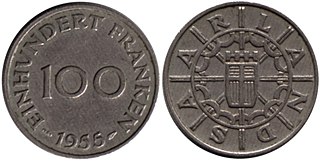
The franc is any of various units of currency. One franc is typically divided into 100 centimes. The name is said to derive from the Latin inscription francorum rex used on early French coins and until the 18th century, or from the French franc, meaning "frank".

Guilder is the English translation of the Dutch and German gulden, originally shortened from Middle High German guldin pfenninc "gold penny". This was the term that became current in the southern and western parts of the Holy Roman Empire for the Fiorino d'oro. Hence, the name has often been interchangeable with florin.
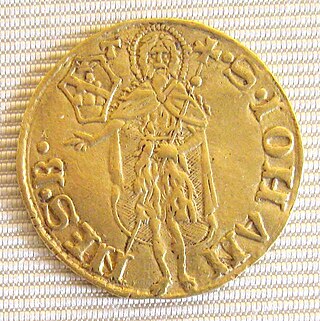
The Florentine florin was a gold coin struck from 1252 to 1533 with no significant change in its design or metal content standard during that time. It had 54 grains of nominally pure or 'fine' gold with a purchasing power difficult to estimate but ranging according to social grouping and perspective from approximately 140 to 1,000 modern US dollars. The name of the coin comes from the Giglio bottonato, the floral emblem of the city, which is represented at the head of the coin.

The Swiss franc is the currency and legal tender of Switzerland and Liechtenstein. It is also legal tender in the Italian exclave of Campione d'Italia which is surrounded by Swiss territory. The Swiss National Bank (SNB) issues banknotes and the federal mint Swissmint issues coins.

The Doge of Genoa was the head of state of the Republic of Genoa, a city-state and soon afterwards a maritime republic, from 1339 until the state's extinction in 1797. Originally elected for life, after 1528 the Doges were elected for terms of two years. The Republic was ruled by a small group of merchant families, from whom the doges were selected.

The Republic of Genoa was a medieval and early modern maritime republic from the 11th century to 1797 in Liguria on the northwestern Italian coast. During the Late Middle Ages, it was a major commercial power in both the Mediterranean Sea and the Black Sea. Between the 16th and 17th centuries, it was one of the major financial centers in Europe.

The ducat coin was used as a trade coin in Europe from the later Middle Ages from the 13th to 19th centuries. Its most familiar version, the gold ducat or sequin containing around 3.5 grams of 98.6% fine gold, originated in Venice in 1284 and gained wide international acceptance over the centuries. Similarly named silver ducatons also existed. The gold ducat circulated along with the Florentine florin and preceded the modern British pound sterling and the United States dollar.

The Belgian franc was the currency of the Kingdom of Belgium from 1832 until 2002 when the Euro was introduced. It was subdivided into 100 subunits, each known as a centiem in Dutch, centime in French or a Centime in German.

The Austro-Hungarian gulden was the currency of the lands of the House of Habsburg between 1754 and 1892, when it was replaced by the Austro-Hungarian krone as part of the introduction of the gold standard. In Austria, the gulden was initially divided into 60 kreuzers. The currency was decimalized in 1857, using the same names for the unit and subunit.

The lira was the currency of the Kingdom of Sardinia between August 6, 1816, and March 17, 1861.
The lira was the distinct currency of Venice until 1848, when it was replaced by the Italian lira. It originated from the Carolingian monetary system used in much of Western Europe since the 8th century CE, with the lira subdivided into 20 soldi, each of 12 denari.

The maritime republics, also called merchant republics, were Italian thalassocratic port cities which, starting from the Middle Ages, enjoyed political autonomy and economic prosperity brought about by their maritime activities. The term, coined during the 19th century, generally refers to four Italian cities, whose coats of arms have been shown since 1947 on the flags of the Italian Navy and the Italian Merchant Navy: Amalfi, Genoa, Pisa, and Venice. In addition to the four best known cities, Ancona, Gaeta, Noli, and, in Dalmatia, Ragusa, are also considered maritime republics; in certain historical periods, they had no secondary importance compared to some of the better known cities.
The Venetian grosso is a silver coin first introduced in Venice in 1193 under doge Enrico Dandolo. It originally weighed 2.18 grams, was composed of 98.5% pure silver, and was valued at 26 denarii. Its name is from the same root as groschen and the English groat, all deriving ultimately from the denaro grosso.

Italy has a long history of different coinage types, which spans thousands of years. Italy has been influential at a coinage point of view: the medieval Florentine florin, one of the most used coinage types in European history and one of the most important coins in Western history, was struck in Florence in the 13th century, while the Venetian sequin, minted from 1284 to 1797, was the most prestigious gold coin in circulation in the commercial centers of the Mediterranean Sea.

The Coinage of the Republic of Venice include the coins produced by the Republic of Venice from the late 12th century to 1866. After this date, coins were still produced in Venice.
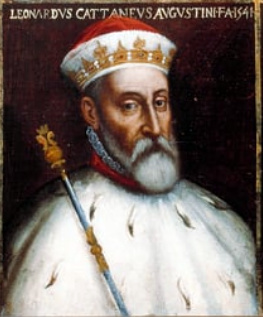
Leonardo Cattaneo della Volta was the 52nd Doge of the Republic of Genoa.
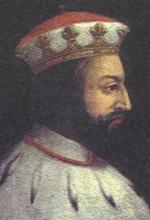
Giorgio Adorno was a statesman who became doge of the Republic of Genoa for two years. His father was Adornino Adorno and his mother Nicolosia della Rocca and his brother, Antoniotto, was elected four times as doge of the Republic. He was born c. 1350 but little is known about his youth except that he married Pietrina Montaldo, daughter of the doge Leonardo Montaldo. With her he had nine children, including the future doge Raffaele Adorno.
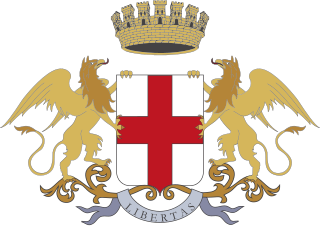
Barnaba Guano was the 23rd Doge of the Republic of Genoa.

Alerame Maria Pallavicini (30 September 1730 - 30 December 1805) was the 181st Doge of his native Republic of Genoa.
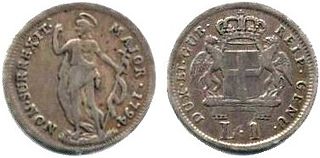
The Genoese lira was the currency of the Republic of Genoa until 1797.